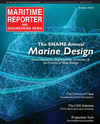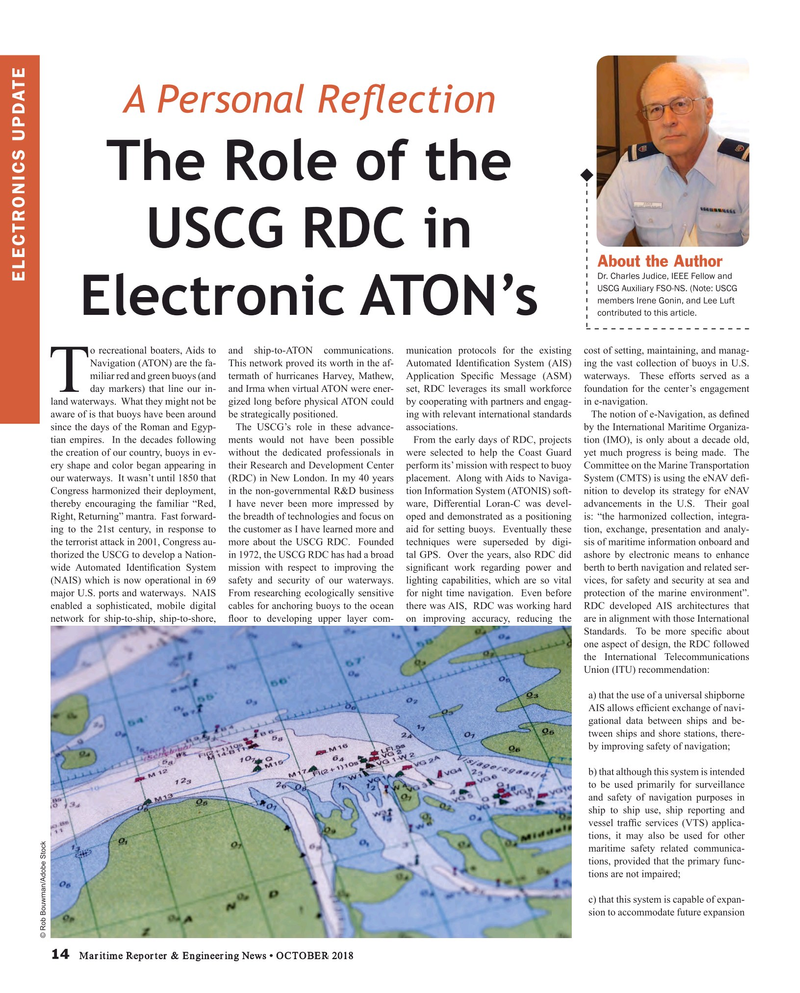
Page 14: of Maritime Reporter Magazine (October 2018)
Marine Design Annual
Read this page in Pdf, Flash or Html5 edition of October 2018 Maritime Reporter Magazine
A Personal Re? ection
The Role of the
USCG RDC in
About the Author
Dr. Charles Judice, IEEE Fellow and
ELECTRONICS UPDATE
USCG Auxiliary FSO-NS. (Note: USCG members Irene Gonin, and Lee Luft
Electronic ATON’s contributed to this article.
o recreational boaters, Aids to and ship-to-ATON communications. munication protocols for the existing cost of setting, maintaining, and manag-
Navigation (ATON) are the fa- This network proved its worth in the af- Automated Identi? cation System (AIS) ing the vast collection of buoys in U.S. miliar red and green buoys (and termath of hurricanes Harvey, Mathew, Application Speci? c Message (ASM) waterways. These efforts served as a
Tday markers) that line our in- and Irma when virtual ATON were ener- set, RDC leverages its small workforce foundation for the center’s engagement land waterways. What they might not be gized long before physical ATON could by cooperating with partners and engag- in e-navigation. aware of is that buoys have been around be strategically positioned. ing with relevant international standards The notion of e-Navigation, as de? ned since the days of the Roman and Egyp- The USCG’s role in these advance- associations. by the International Maritime Organiza- tian empires. In the decades following ments would not have been possible From the early days of RDC, projects tion (IMO), is only about a decade old, the creation of our country, buoys in ev- without the dedicated professionals in were selected to help the Coast Guard yet much progress is being made. The ery shape and color began appearing in their Research and Development Center perform its’ mission with respect to buoy Committee on the Marine Transportation our waterways. It wasn’t until 1850 that (RDC) in New London. In my 40 years placement. Along with Aids to Naviga- System (CMTS) is using the eNAV de? -
Congress harmonized their deployment, in the non-governmental R&D business tion Information System (ATONIS) soft- nition to develop its strategy for eNAV thereby encouraging the familiar “Red, I have never been more impressed by ware, Differential Loran-C was devel- advancements in the U.S. Their goal
Right, Returning” mantra. Fast forward- the breadth of technologies and focus on oped and demonstrated as a positioning is: “the harmonized collection, integra- ing to the 21st century, in response to the customer as I have learned more and aid for setting buoys. Eventually these tion, exchange, presentation and analy- the terrorist attack in 2001, Congress au- more about the USCG RDC. Founded techniques were superseded by digi- sis of maritime information onboard and thorized the USCG to develop a Nation- in 1972, the USCG RDC has had a broad tal GPS. Over the years, also RDC did ashore by electronic means to enhance wide Automated Identi? cation System mission with respect to improving the signi? cant work regarding power and berth to berth navigation and related ser- (NAIS) which is now operational in 69 safety and security of our waterways. lighting capabilities, which are so vital vices, for safety and security at sea and major U.S. ports and waterways. NAIS From researching ecologically sensitive for night time navigation. Even before protection of the marine environment”. enabled a sophisticated, mobile digital cables for anchoring buoys to the ocean there was AIS, RDC was working hard RDC developed AIS architectures that network for ship-to-ship, ship-to-shore, ? oor to developing upper layer com- on improving accuracy, reducing the are in alignment with those International
Standards. To be more speci? c about one aspect of design, the RDC followed the International Telecommunications
Union (ITU) recommendation: a) that the use of a universal shipborne
AIS allows ef? cient exchange of navi- gational data between ships and be- tween ships and shore stations, there- by improving safety of navigation; b) that although this system is intended to be used primarily for surveillance and safety of navigation purposes in ship to ship use, ship reporting and vessel traf? c services (VTS) applica- tions, it may also be used for other maritime safety related communica- tions, provided that the primary func- tions are not impaired; c) that this system is capable of expan- sion to accommodate future expansion © Rob Bouwman/Adobe Stock 14 Maritime Reporter & Engineering News • OCTOBER 2018
MR #10 (10-17).indd 14 MR #10 (10-17).indd 14 10/4/2018 10:47:43 AM10/4/2018 10:47:43 AM

 13
13

 15
15
